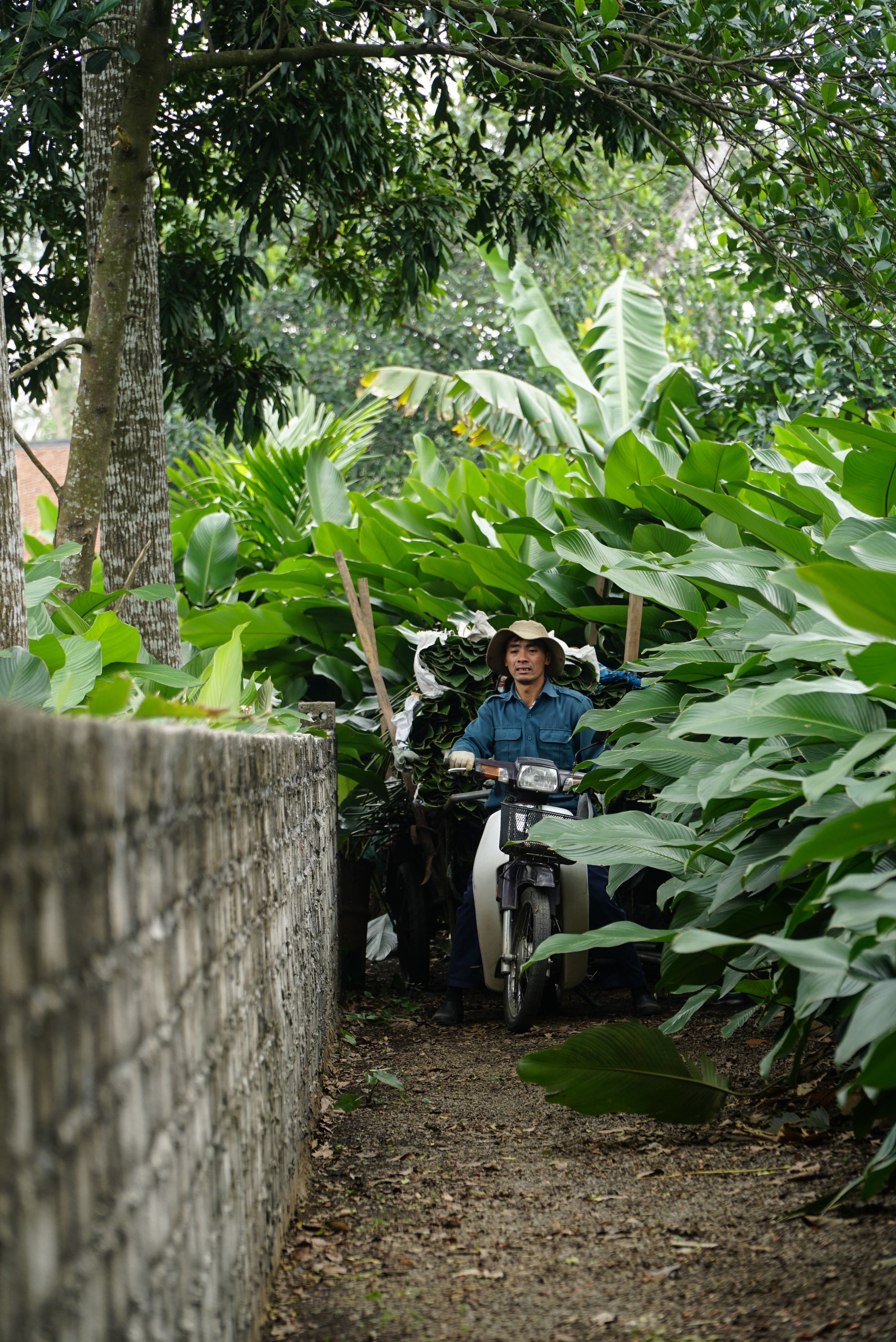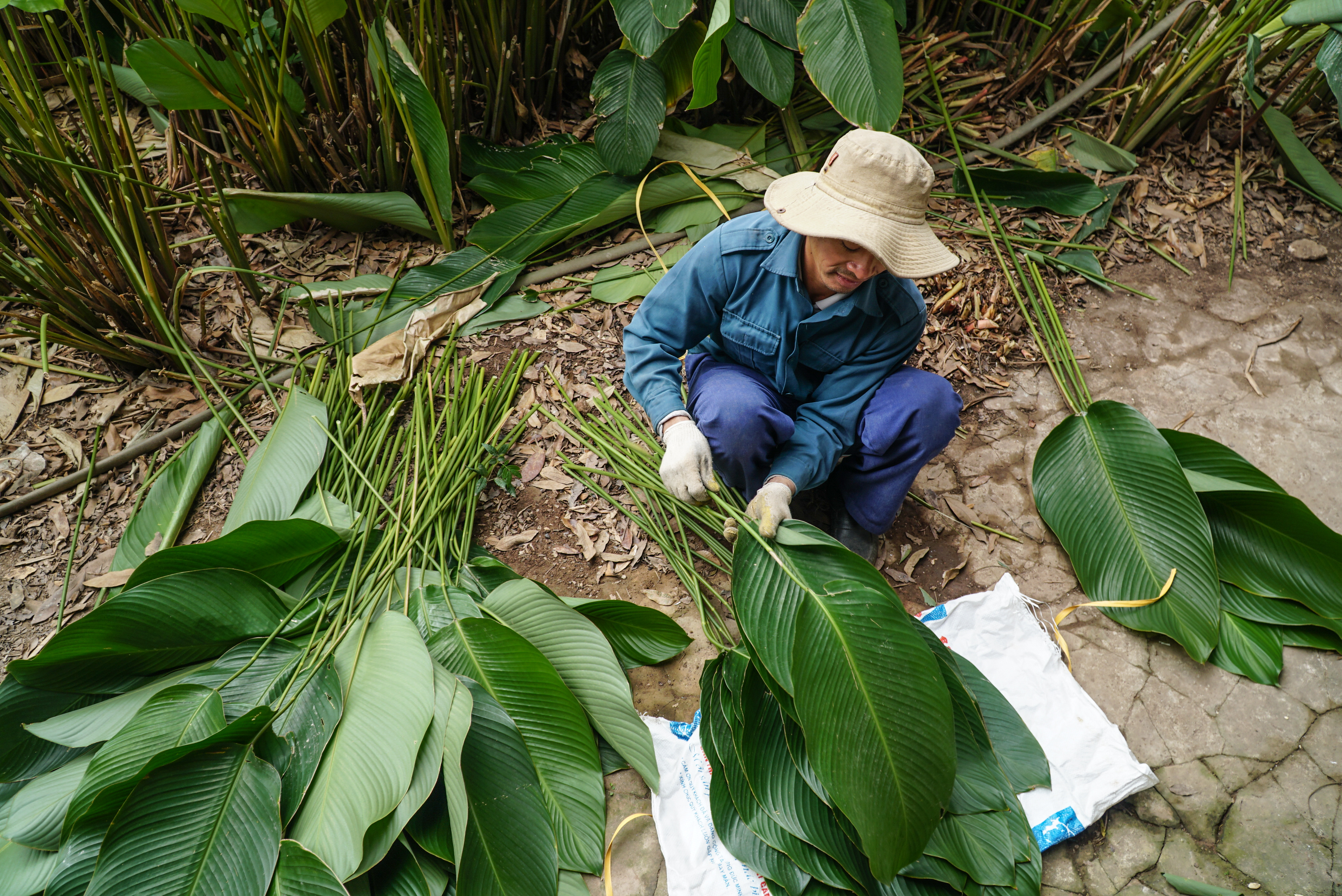‘Dong,’ or arrowroot (Phrynium placentarium), leaves are often used for wrapping various Vietnamese dishes, most popularly ‘banh chung’ – a square, glutinous rice cake filled with mung beans and pork which is considered an indispensable part of the Lunar New Year (Tet) holiday.
Trang Cat Village is famous in the northern region for its 600-year history of growing and harvesting ‘dong’ leaves.
Each and every ‘dong’ plant in Trang Cat is carefully grown to ensure quality and color, according to Chu Thi Thanh, a ‘dong’ leaf farmer in the village.
Harvesting ‘dong’ leaves is difficult work that often requires entire households to chip in, especially on large farms like Thanh’s 720 square-meter plantation.
|

|
|
Nguyen Van Tu arranges ‘dong’ leaves after harvesting in Trang Cat Village, Thanh Oai District, Hanoi. Photo: Nguyen Hien / Tuoi Tre
|
After being harvested, ‘dong’ leaves are sorted by size, soaked in water, and neatly stacked, according to Thanh.
The leaves are then tied together in bundles of 50, each of which is sold for VND40,000-60,000 (US$1.7-2.5).
Thanh’s family expects to harvest about 30,000 ‘dong’ leaves this season.
Phan Thi Tuan, one of Thanh’s neighbors, owns a 1,440-square-meter ‘dong’ plantation and has hired ten workers to help with this harvest season’s workload.
“If the leaves are harvested too early, they can be damaged easily,” said Tuan.
“But if we wait too long, we won’t be able to sell them in time for Tet.”
In the last two weeks before the 2023 Lunar New Year, which falls on January 22, Tuan’s family are working at full capacity, from dusk to dawn, with only a lunch break each day.
|

|
| Chu Thi Thanh harvests ‘dong’ leaves in a field in Trang Cat Village, Thanh Oai District, Hanoi. Photo: Nguyen Hien / Tuoi Tre |
|

|
| Nguyen Van Tu carries ‘dong’ leaves home on a motorbike after harvesting in Trang Cat Village, Thanh Oai District, Hanoi. Photo: Nguyen Hien / Tuoi Tre |
|

|
| Nguyen Hien arranges ‘dong’ leaves by size in her yard in Trang Cat Village, Thanh Oai District, Hanoi. Photo: Nguyen Hien / Tuoi Tre |
|

|
| A farmer arranges ‘dong’ leaves by size in Trang Cat Village, Thanh Oai District, Hanoi. Photo: Nguyen Hien / Tuoi Tre |
|

|
| Nguyen Hien harvests ‘dong’ leaves in a field in Trang Cat Village, Thanh Oai District, Hanoi. Photo: Nguyen Hien / Tuoi Tre |
|

|
| Nguyen Van Tu soaks ‘dong’ leaves in water after harvesting in Trang Cat Village, Thanh Oai District, Hanoi. Photo: Nguyen Hien / Tuoi Tre |
Like us on Facebook or follow us on Twitter to get the latest news about Vietnam!
With the Lunar New Year fast approaching, Trang Cat Village in Thanh Oai District, Hanoi is bustling as locals rush to harvest enough ‘dong’ leaves to meet the holiday season demand.
‘Dong,’ or arrowroot (Phrynium placentarium), leaves are often used for wrapping various Vietnamese dishes, most popularly ‘banh chung’ – a square, glutinous rice cake filled with mung beans and pork which is considered an indispensable part of the Lunar New Year (Tet) holiday.
Trang Cat Village is famous in the northern region for its 600-year history of growing and harvesting ‘dong’ leaves.
Each and every ‘dong’ plant in Trang Cat is carefully grown to ensure quality and color, according to Chu Thi Thanh, a ‘dong’ leaf farmer in the village.
Harvesting ‘dong’ leaves is difficult work that often requires entire households to chip in, especially on large farms like Thanh’s 720 square-meter plantation.
|

|
|
Nguyen Van Tu arranges ‘dong’ leaves after harvesting in Trang Cat Village, Thanh Oai District, Hanoi. Photo: Nguyen Hien / Tuoi Tre
|
After being harvested, ‘dong’ leaves are sorted by size, soaked in water, and neatly stacked, according to Thanh.
The leaves are then tied together in bundles of 50, each of which is sold for VND40,000-60,000 (US$1.7-2.5).
Thanh’s family expects to harvest about 30,000 ‘dong’ leaves this season.
Phan Thi Tuan, one of Thanh’s neighbors, owns a 1,440-square-meter ‘dong’ plantation and has hired ten workers to help with this harvest season’s workload.
“If the leaves are harvested too early, they can be damaged easily,” said Tuan.
“But if we wait too long, we won’t be able to sell them in time for Tet.”
In the last two weeks before the 2023 Lunar New Year, which falls on January 22, Tuan’s family are working at full capacity, from dusk to dawn, with only a lunch break each day.
|

|
| Chu Thi Thanh harvests ‘dong’ leaves in a field in Trang Cat Village, Thanh Oai District, Hanoi. Photo: Nguyen Hien / Tuoi Tre |
|

|
| Nguyen Van Tu carries ‘dong’ leaves home on a motorbike after harvesting in Trang Cat Village, Thanh Oai District, Hanoi. Photo: Nguyen Hien / Tuoi Tre |
|

|
| Nguyen Hien arranges ‘dong’ leaves by size in her yard in Trang Cat Village, Thanh Oai District, Hanoi. Photo: Nguyen Hien / Tuoi Tre |
|

|
| A farmer arranges ‘dong’ leaves by size in Trang Cat Village, Thanh Oai District, Hanoi. Photo: Nguyen Hien / Tuoi Tre |
|

|
| Nguyen Hien harvests ‘dong’ leaves in a field in Trang Cat Village, Thanh Oai District, Hanoi. Photo: Nguyen Hien / Tuoi Tre |
|

|
| Nguyen Van Tu soaks ‘dong’ leaves in water after harvesting in Trang Cat Village, Thanh Oai District, Hanoi. Photo: Nguyen Hien / Tuoi Tre |
Like us on Facebook or follow us on Twitter to get the latest news about Vietnam!
NDO – Hanoi has planned to organise flower markets at 51 locations across all its districts to meet the demands for shopping and entertainment on the occasion of the Lunar New Year (Tet) 2020.
With favourable natural conditions, the Mekong delta region is home to diverse fruit species. When Tet (Lunar New Year) comes, exotic fruits are offered for sales to serve people’s demand.
As Tet (Lunar New Year) comes, most locals in Vinh Hoa village, Yen Thanh district, Nghe An province make chung cakes for sale, creating a bustling atmosphere here.
Vineyards in NinhThuan province are busy preparing tens of thousands of pots of ornamental grape vines with new designs for the upcoming Lunar New Year 2020.
PM Nguyen Xuan Phuc on Feb.4 chaired a working session between the government’s standing board and leaders of relevant ministries on the result of nCov prevention and control.
















